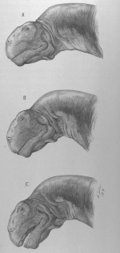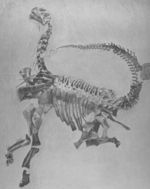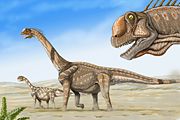Camarasaurus
2008/9 Schools Wikipedia Selection. Related subjects: Dinosaurs
| Camarasaurus Fossil range: Late Jurassic |
||||||||||||||||||
|---|---|---|---|---|---|---|---|---|---|---|---|---|---|---|---|---|---|---|
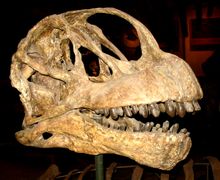 Camarasaurus lentus skull
|
||||||||||||||||||
| Scientific classification | ||||||||||||||||||
|
||||||||||||||||||
| Species | ||||||||||||||||||
|
||||||||||||||||||
| Synonyms | ||||||||||||||||||
|
Camarasaurus (pronounced /ˌkæmərəˈsɔrəs/ KAM-uh-ruh-SAWR-us) meaning 'chambered lizard', referring to the holes in its vertebrae (Greek kamara meaning 'vaulted chamber', or anything with an arched cover, and sauros meaning 'lizard') was a genus of quadrupedal, herbivorous dinosaurs. It was the most common of the giant sauropods to be found in North America but only average in size: about 18 meters (60 ft) in length as adults, and weighing up to 18 tonnes (19.8 tons). It lived in the Late Jurassic Period, between 155 and 145 million years ago.
Anatomy
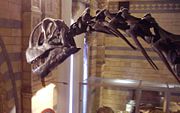
The arched skull of Camarasaurus may have contributed to the name 'chambered lizard'. The skull was remarkably square and the blunt snout had many fenestrae, though it was sturdy and is frequently recovered in good condition by paleontologists.
The 19 centimeter long (7.5 in) teeth were shaped like chisels (spatulate) and arranged evenly along the jaw. The strength of the teeth indicates that Camarasaurus probably ate coarser plant material than the slender-toothed diplodocids. Like a chicken, it may have swallowed stones ( gastroliths) to help grind the food in the stomach and then regurgitated or passed them when they became too smooth.
Each giant foot bore five toes, with the inner toe having a large sharpened claw for self-defense. Like most sauropods, the front legs were shorter than the hind legs, but the high position of the shoulders meant there was little slope in the back. In some sauropods, there were long upward projections on each vertebra but the absence of such structures from the spine of Camarasaurus suggests that it was not able to raise itself on its hind legs.
The vertebrae were nevertheless specialised. Serving the purpose of weight-saving, as seen in many later sauropods, some of the vertebrae were hollowed out. This feature may have contributed to the name "chambered lizard". Like a modern elephant, Camarasaurus appears to have had a wedge of spongy tissue at the base of the heel, to support the weight of such a large creature. The neck and counter-balancing tail were shorter than usual for a sauropod of this size.
Camarasaurus, again like certain other sauropods, had an enlargement of the spinal cord near the hips. Palaeontologists originally believed this to be a second brain, perhaps necessary to co-ordinate such a huge creature. Modern opinion asserts that, while it would have been an area of large nervous possibly reflex (automatic) activity, it was not a brain. However, this enlargement was actually larger than the remarkably small brain contained in the animals' box-like skull.
Behaviour
There is a fossil record of two adults and a 12.2 meter (40 ft) long juvenile that died together in the Late Jurassic Period, approximately 150 million years ago (in north east Wyoming, USA, excavated by the Division of Vertebrate Paleontology of the University of Kansas Natural History Museum and Biodiversity Centre, during the 1997 and 1998 'field seasons'). It is assumed that their bodies were washed to their final resting place, in alluvial mud, by a river in spate. This suggests that Camarasaurus traveled in herds or, at least, 'family' groups. Also, recovered camarasaur eggs have been found in lines, rather than in neatly arranged nests as with some other dinosaurs, which appears to suggest that, like most sauropods, Camarasaurus did not tend its young.
Discovery
The first record of Camarasaurus comes from 1877, when a few scattered vertebrae were located in Colorado, by Oramel W. Lucas. The paleontologist Edward Drinker Cope paid for the bones, as part of his long-running and acrimonious competition with Othniel Charles Marsh (known as the Bone Wars) and named them in the same year. Marsh later named some of his sauropod findings Morosaurus grandis but most paleontologists today consider this to be a species of Camarasaurus . Such naming conflicts were common between the two rival dinosaur hunters, the most famous being Brontosaurus/Apatosaurus.
It was not until 1925 that a complete skeleton of Camarasaurus was recovered, by Charles W. Gilmore. However, it was the skeleton from a young Camarasaurus, which is why so many illustrations of the dinosaur from the time show it to be much smaller than it is now known to be.
The Morrison Formation, along the eastern flank of the Rocky Mountains, is home to a rich stretch of Late Jurassic rock. A large number of dinosaur species can be found here, including relatives of the Camarasaurus such as Diplodocus, Apatosaurus and Brachiosaurus. However, camarasaurs are the most abundant of all the dinosaurs in the Formation and there have been a number of complete skeletons recovered from Colorado, New Mexico, Utah, and Wyoming.
Classification
The scientific classification of Camarasaurus, using the Linnaean system, is given in the box to the upper right but, among palaeontologists, this method of taxonomic classification of dinosaurs is being supplanted by the cladistics inspired phylogenetic taxonomy. A simplified version of one possible branching evolutionary tree, showing the relationship between Camarasaurus and the other major groups of sauropods, follows:
Saurischia ("lizard hipped" dinosaurs) `-- Sauropoda ("lizard feet") |-- Macronaria ("large nostrils") | |--Camarasauridae | `-- Titanosauriformes | |-- Brachiosauridae (which includes Brachiosaurus and Sauroposeidon) | `--Titanosauria (dinosaurs such as Argentinosaurus) `-- Diplodocoidea (which includes Apatosaurus and Diplodocus)
Camarasaurus is considered to be a basal macronarian, more closely related to the common ancestor of all macronarians than to more derived forms like Brachiosaurus.
The type species of Camarasaurus is Cope's original species, C. supremus ("the biggest chambered lizard"), named in 1877. Other species since discovered include C. grandis ("grand chambered lizard") in 1877, C. lentus in 1889, and C. lewisi (originally Cathetosaurus) in 1988.
